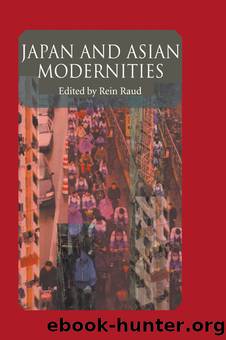Japan And Asian Modernities by Raud

Author:Raud [Raud]
Language: eng
Format: epub
ISBN: 9780710311030
Google: Y3ssBgAAQBAJ
Barnesnoble:
Publisher: Taylor & Francis
Published: 2007-05-30T00:00:00+00:00
The Pacific War as a philosophical war
If conservatives could be satisfied that the effects liberalism of the previous decades was being rectified by the mid-1930s â a repudiating process in both domestic and foreign affairs that sought to correct âdamageâ â then 1937 can be seen as a crucial year signifying an affirming process that sought to push the conservative vision forward in both foreign and domestic policies. Overseas, under the Prince Konoe Government, Japan began the China War to attempt a âfinal solutionâ to the âChina Problemâ. Domestically, the Ministry of Education published the Kokutai no hongi (The Fundamental Principles of the National Essence), which formally established the (conservative) official definition of Japanâs national essence over which liberals and conservatives had fought the previous decade. The document signified not only the governmentâs aim to direct peopleâs thinking, but also the end of the decades-long illiberal struggle to define Japanese civilization.
The Kokutai no hongi explicitly criticized âEuropeanizationâ and âideologies of the Enlightenmentâ along with rationalism, positivism, and what its authors called the âdeadlock of individualismâ. In order to counteract these influences, two things needed to happen: (1) there needed to be a deeper understanding of the âintrinsic nature of Occidental ideologiesâ, and (2) people needed to grasp âthe true nature of [Japanâs] national entityâ. People needed to embrace anew the virtue of loyalty to the organic family-state and to the divine emperor. This required properly understanding individuals as subjects, and that the individual gained value through connection to the state:
When citizens who are conglomerations of separate individuals independent of each other give support to a ruler in correlation to the ruler, there exists no deep foundation between ruler and citizen to unite them. However, the relationship between the Emperor and his subjects arises from the same fountainhead, and has prospered ever since the founding of the nation as one in essence. ⦠We must sweep aside the corruption of the spirit and the clouding of knowledge that arises from setting up oneâs âselfâ and from being taken up with oneâs self and return to a pure and clear state of mind that belongs intrinsically to us as subjects, and thereby fathom the great principle of loyalty (KNH 1937:79, 82).
According to the Kokutai no hongi, the individual, then, was one in essence with the state, the former owing the latter for his origins. The individual was nothing when separated from the state. The proper understanding of the Emperor, the state, and the âselfâ that had been lost due to the influence of Occidental individualist ideology needed to be regained. What is evident here is the Hegelian notion that states play the preeminent roles in the movement of history. The Japanese subjectâs existence was validated only through social and philosophical entities greater than the individual self, ultimately the throne and state. The official state document made clear what did not lead to a healthy Japanese culture:
No true culture should be the fruit of abstract individual ideas alienated from the State and the race.
Download
This site does not store any files on its server. We only index and link to content provided by other sites. Please contact the content providers to delete copyright contents if any and email us, we'll remove relevant links or contents immediately.
The European History Highway: A Guide to Internet Resources by Dennis A. Trinkle Scott A. Merriman(494)
The Seven Wonders of the Ancient World by Michael Denis Higgins(478)
European Security in a Global Context by Thierry Tardy(470)
European Security without the Soviet Union by Stuart Croft Phil Williams(469)
The Routledge companion to Christian ethics by D. Stephen Long Rebekah L. Miles(458)
Hudud Al-'Alam 'The Regions of the World' - a Persian Geography 372 A.H. (982 AD) by V. V. Minorsky & C. E. Bosworth(399)
Gorbachev And His Generals by William C. Green(391)
Get Real with Storytime by Julie Dietzel-Glair & Marianne Crandall Follis(390)
Tibetan Studies in Comparative Perspective by Chih-yu Shih Yu-Wen Chen(385)
Governance, Growth and Global Leadership by Espen Moe(381)
Hyperculture by Byung-Chul Han(378)
CliffsNotes on Fitzgerald's The Great Gatsby by Kate Maurer(360)
The Oxford History of the World by Fernández-Armesto Felipe;(354)
How Languages Are Learned 5th Edition by Patsy M Lightbown;Nina Spada; & Nina Spada(353)
The Egyptian Economy, 1952-2000 by Khalid Ikram(352)
Oral Poetry and Narratives from Central Arabia: The Poetry of Ad-Dindan : A Bedouin Bard in Southern Najd (Studies in Arabic Literature, Vol 17) (English and Arabic Edition) by P. M. Kupershoek P. Marcel Kurpershoek(345)
The Oxford Handbook of the Incas by Sonia Alconini(333)
Europe Contested by Harold James(319)
The Hutchinson Dictionary of Ancient and Medieval Warfare by Peter Connolly John Gillingham John Lazenby(305)
